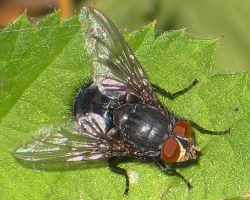Calliphora vomitoria: Difference between revisions
No edit summary |
No edit summary |
||
| Line 27: | Line 27: | ||
[[Category:Flies]] |
[[Category:Flies]] |
||
[[ |
[[fr:mouche bleue]] |
||
Revision as of 20:43, 6 February 2007
| Blue bottle fly | |
|---|---|

| |
| Scientific classification | |
| Kingdom: | |
| Phylum: | |
| Class: | |
| Order: | |
| Family: | |
| Genus: | Calliphora
|
| Species: | C. vomitoria
|
| Binomial name | |
| Calliphora vomitoria | |
The blue bottle fly (Calliphora vomitoria) is a common blow-fly found in most areas of the world. It is 10-14 mm long, slightly larger than a housefly. The head and thorax are dull gray and the abdomen is bright metallic blue with black markings. Its body and legs are covered with black bristle-like hair. The eyes are red and the wings are clear. The legs and antennae are black.
Life cycle
A female blue bottle fly lays her eggs where she feeds, usually in decaying meat, garbage, or feces. Pale whitish larvae, commonly called maggots, soon hatch from the eggs and immediately begin feeding on the decomposing matter where they were hatched. After a few days of feeding, they are fully grown. At that time they will crawl away to a dry place where they can burrow into soil or similar matter to pupate into tough brown coccoons. After two or three weeks, the adults emerge to mate, beginning the cycle again. During cold weather, pupae and adults can hibernate until warmer temperatures revive them.
They are pollinators of some flowers with a strong odor such as skunk cabbage and goldenrod.
